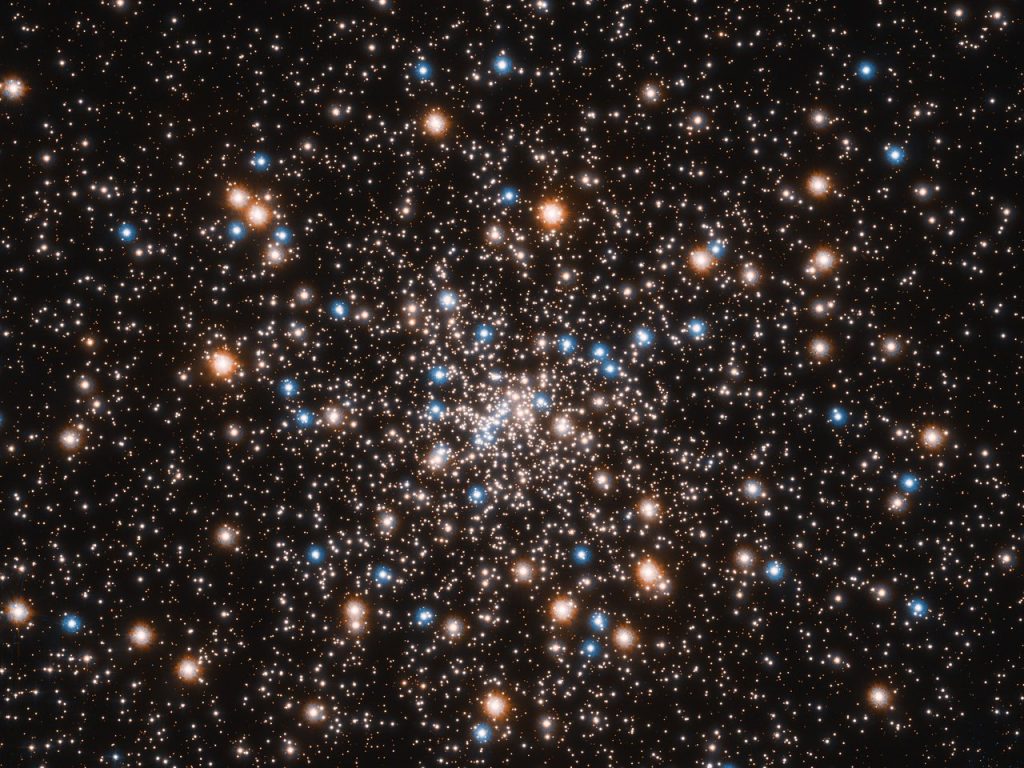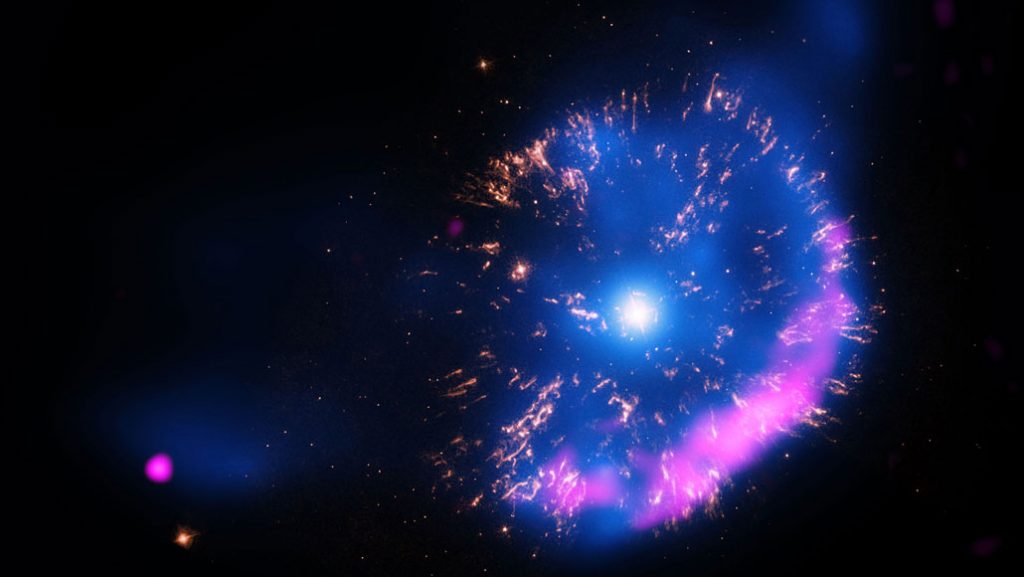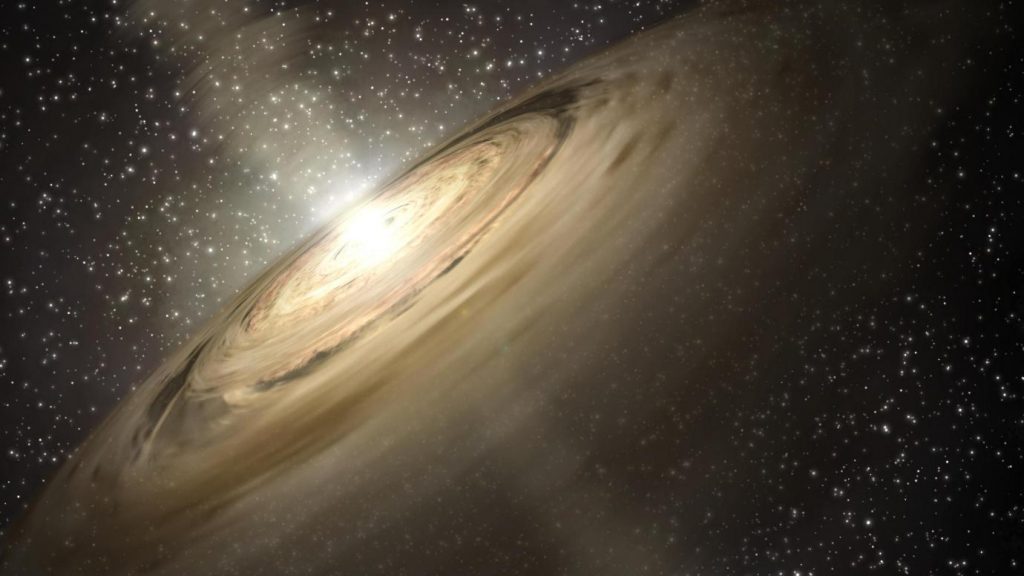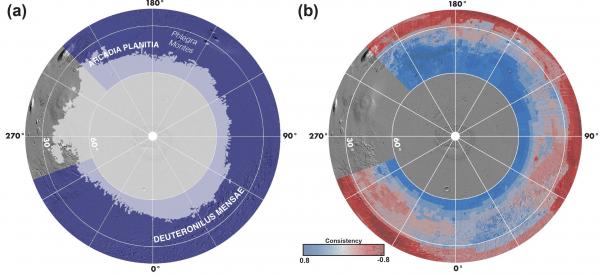While searching for an intermediate-mass black hole, scientists instead found a cluster of smaller black holes in the globular cluster NGC 6397. Plus, supernovae, meteorites, and an interview about mapping water ice on Mars with guests Gareth Morgan and Than Putzig from the Planetary Science Institute.
Media
Transcript
Hello and welcome to the Daily Space. I am your host Dr. Pamela Gay.
And I am your host Beth Johnson.
And we are here to put science in your brain.
Today we are going to be joined by Gareth Morgan and Than Putzig to discuss their new paper on mapping water-ice reserves found on Mars. Before we get to that, however, we have a universe of news.
Our first story looks deep into the heart of the nearby globular cluster NGC 6397. Observable from the southern hemisphere, this knot of thousands of stars is the second closest globular cluster to our solar system and is close enough for the Gaia and Hubble space telescopes and larger ground scopes to readily resolve individual stars in all but the densest part of the system’s core.

With Gaia and Hubble, high-resolution images taken over time make it possible to actually measure how stars’ positions on the sky change as the stars orbit. The Very Large Telescope’s MUSE spectrograph also allowed motions along the line of sight, that direction in and out of the sky, to also be measured. Put together, these three-dimensional orbital motions make it possible to map out the distribution of unseen mass in the cluster.
In a new paper in Astronomy & Astrophysics, Eduardo Vitral and Gary Mamon discuss how these motions could be explained by a central intermediate-mass black hole with a mass of 500-650 solar masses, but more could be better explained with a population of myriad compact dead stars: white dwarfs, neutron stars, and stellar-mass black holes that together have a mass of 1000-2000 solar masses.
Put differently, one more place where we expected to find an intermediate-mass black hole did not obviously have one. We thought, apparently falsely, that black holes created during the death knells of the largest stars — the so-called stellar-mass black holes — would merge together into bigger and bigger black holes – the intermediate-mass black holes we keep just not finding.
And the question is why. Why do we keep not finding intermediate-mass black holes?
In the case of NGC 6397, the answer may be dynamics. According to the paper, the merger process can give the resulting object a kick that can accelerate the resulting object up to escape velocities. This globular cluster has an escape velocity of around 50 km/s, and models of mergers in this system indicate that 70 – 85% of black hole mergers would result in the intermediate-mass black hole flying out of the globular cluster. This raises the disturbing possibility that the halo of the Milky Way and other galaxies are full of intermediate-mass black holes that are doing nothing more than hanging out and avoiding detection.
For now, this is largely a statistical argument: a myriad of dead stars fit the data better than a single large intermediate-mass black hole. The real proof could come from detecting the merger of stellar black holes (and the flinging away of the resulting intermediate-mass black hole).
Statistical arguments are how we understand a remarkable number of things in astronomy. Let’s face it, the sky is big, daylight and clouds happen, and we just can’t watch everything, everywhere, all of the time. Instead, we’ll observe where we can, when we can, and then we use statistics to figure out how common different things may be.

A new paper in The Astrophysical Journal with first author Kishalay De documents how a new team used the Palomar telescope to look for novae — the bright explosions of material falling onto a white dwarf from a companion star. With careful statistics, they were able to jump from the number of novae detected in their images to the number of novae taking place in our galaxy each year. By accounting for how much of the galaxy is blocked by dust and how much of the sky was and was not observed, they estimated that 46 +/- 13 novae go off in our galaxy every year.
While not entirely exciting on its own, this research is going to do a lot to help astronomers model the chemical evolution of galaxies. Each of the novae transforms material from one set of simple atoms to a more complicated set of atoms, and these atoms are the ones needed to form planets, plants, and people. By better understanding the nova rate, we can better understand the chemical evolution rate and eventually the planet-forming rate.
Go statistics.
Speaking of novae, it turns out that we can actually measure the amount of planetary debris in the outer layers of those white dwarf stars.

In a new paper published in Nature Astronomy, astronomers from the University of Warwick report on findings from observations of white dwarfs using data from the Gaia telescope. First, they found one unusual signal in the spectroscopic data, which they were using to analyze the composition of the outer layers. The signal turned out to be lithium, and as we have repeatedly mentioned, when you find one example, there are likely more out there. So they dug through the data and found three more white dwarfs with a lithium signal. And found one of those white dwarfs had potassium as well.
The team then compared the amounts of lithium and potassium they found with the amounts of sodium and calcium observed. All of these comparisons led to the conclusion that the chemical composition matched the crusts of rocky planets like Earth and Mars — planets that had been vaporized by the stars’ novae.
Lead author Dr. Mark Hollands said: In the past, we’ve seen all sorts of things like mantle and core material, but we’ve not had a definitive detection of planetary crust. Lithium and potassium are good indicators of crust material, they are not present in high concentrations in the mantle or core. Now we know what chemical signature to look for to detect these elements, we have the opportunity to look at a huge number of white dwarfs and find more of these. Then we can look at the distribution of that signature and see how often we detect these planetary crusts and how that compares to our predictions.
These results are pretty amazing on a couple of levels. One, we’d not yet seen evidence of crustal material in these stars, although we had seen evidence of mantle and core material. And two, the four stars sampled burned out their fuel up to 10 billion years ago, making them some of the oldest in the Milky Way. Co-author Dr. Pier-Emmanuel Tremblay said: In one case, we are looking at planet formation around a star that was formed in the Galactic halo, 11-12.5 billion years ago, hence it must be one of the oldest planetary systems known so far. Another of these systems formed around a short-lived star that was initially more than four times the mass of the Sun, a record-breaking discovery delivering important constraints on how fast planets can form around their host stars.
These new findings once again change ideas we’ve harbored about planetary formation and system evolution. But you knew that was coming, didn’t you?
From rocky planet fragments in the outer layers of white dwarfs, we turn to ceramic chips embedded in meteorites and break our previously held theories a little more.
Let’s start with the earlier theory that our Sun cooled gently and steadily over time, and the surrounding solar gas quietly condensed, creating these ceramic chips that ended up in meteorites. Then take one graduate student, Justin Hu, and let him analyze those chips using some of that radiometric dating we’ve been explaining the past week or so. Shake in a patented purification system developed by his research lab, and voila! You break a planetary formation theory.

As Hu explains: The results indicated that temperatures these ceramic inclusions encountered as they formed would have been over 1,600 Kelvin—or about 2,400 degrees Fahrenheit—over tens to hundreds of years.
What does that actually mean? It means that our Sun was not as quiet and gentle as previously thought and was, in fact, flaring and experiencing temperature fluctuations that affected the surrounding environment. However, to be fair, we’ve seen these flares in young stars in other systems. We just didn’t know if our own system had experienced them. So it’s not so much breaking a theory as finding out our solar system, you know, that one example we had for so very long, well, that system actually matches observations elsewhere.
Co-author Andrew M. Davis adds: This isn’t the first evidence that the early stages of our sun were violent years, but there’s a richness to these findings that allows us to say more about the timescale over which this occurred—which is many, many days.
Friendly reminder that science is not static. We can advance what we know by collecting more and more data. Progressing from one stellar system, our own, to many stellar systems means we really do narrow down on those formation processes, even if we keep teasing that we’ll never really know them.
All eyes are on Mars, and even our home institution, the Planetary Science Institute, has gotten into the game. Last week, we announced the release of new maps showing the location of water ice on Mars. A team of scientists, featuring seven from PSI, used data from the Mars Reconnaissance Orbiter, Mars Odyssey, and Mars Global Surveyor to create these maps. The team is a part of the Subsurface Water Ice Mapping on Mars project or SWIM. Which, frankly, is a fantastic acronym.
As lead author Gareth Morgan explains: The goal of SWIM is to provide maps of potential buried ice deposits to support the selection of human landing sites. Ice is a critical resource that has many uses, like the generation of water for human consumption, growing plants for food, and for the generation of methane fuel and breathable air. But the most important is to provide fuel for the return trip home to Earth.

The results were published in Nature Astronomy, and they show that there are broad regions in the mid-latitudes of Mars’ northern hemisphere that have evidence of ice. Now, that ice is subsurface and buried from depths of a few centimeters to about a kilometer, so it will take some work to get to. But it’s there.
The SWIM team (I love saying that) used five different remote sensing techniques to acquire their dataset: neutron spectroscopy, thermal analysis, radar surface analysis, radar subsurface compositional analysis, and geomorphic mapping of the somewhat glacial features. That’s a lot of words, but they all come back to the fact that the work is a broad compilation that narrows down the presence of ice at Mars through the combination of methods.
More work needs to be done before anyone can make decisions about where to send humans on Mars because the resolution of this data is fairly coarse. So let’s welcome Planetary Science Institute senior scientists Gareth Morgan and Than Putzig to talk about all this work. Thank you, gentlemen, for joining us today.
[Interview]
This has been the Daily Space.
Learn More
Hubble Telescope Finds Cluster of Black Holes
- Hubble press release
- “Does NGC 6397 contain an intermediate-mass black hole or a more diffuse inner subcluster?“, Eduardo Vitral and Gary A. Mamon, 2021 February 11, Astronomy & Astrophysics
Scientists Estimate Four Dozen Novae Per Year in Milky Way
- Science News article
- “A population of heavily reddened, optically missed novae from Palomar Gattini-IR: Constraints on the Galactic nova rate,” Kishalay De et al., submitted to The Astrophysical Journal (preprint on arxiv.org)
Remains of Rocky Planets Found In Dying Stars
- University of Warwick press release
- “Alkali metals in white dwarf atmospheres as tracers of ancient planetary crusts,” Mark A. Hollands et al., 2021 February 11, Nature Astronomy
Ceramic Chips in Meteorites Mean Wild Days in Early Solar System
- University of Chicago press release
- “Heating events in the nascent solar system recorded by rare earth element isotopic fractionation in refractory inclusions,” J. Y. Hu et al., 2021 January 6, Science Advances
Water Ice Resources Identified in Martian Northern Hemisphere
- PSI press release
- “Availability of subsurface water-ice resources in the northern mid-latitudes of Mars,” G. A. Morgan et al., 2021 February 8, Nature Astronomy
Credits
Written by Pamela Gay and Beth Johnson
Hosted by Pamela Gay and Beth Johnson
Audio and Video Editing by Ally Pelphrey
Content Editing by Beth Johnson
Intro and Outro music by Kevin MacLeod, https://incompetech.com/music/


 We record most shows live, on Twitch. Follow us today to get alerts when we go live.
We record most shows live, on Twitch. Follow us today to get alerts when we go live.